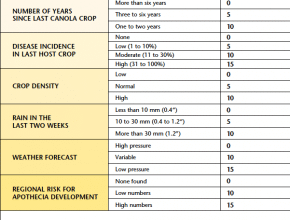Moist conditions increase the sclerotinia stem rot risk. High humidity (even if it doesn’t rain) can promote apothecia to release higher levels of sclerotinia ascospores. Ideal timing for sclerotinia spraying……
July 6, 2011 - Issue 15
-
-
Peace: Weather has been showery and cool, with temperatures rarely over 20 C. Wind is helping to dry out saturated fields. The north region has still not received meaningful precipitation. Most……
-
Fertilizer top dressing right after a hail has been shown in some anecdotal cases to improve canola recovery after a hail, but third party research into this practice is limited. Consider the stage of canola and its chance of recovery before investing in a fertilizer top up…
-
Regrowth after hail may extend the flowering period, which also increases the sclerotinia stem rot risk. If yield potential is still high and if conditions favorable to sclerotinia stem rot persist, then a fungicide spray may pay off…
-
-
A crop needs 40 to 60 frost free days after the start of flowering to reach maturity. That takes us to late August or early September if the crop is flowering today. If a late crop is still two or three weeks from flowering, it is already at high risk of fall frost damage which could negate any economic benefit…
-
Cabbage seedpod weevil adults have arrived and are feeding on volunteer canola at the bloom stage in southern Alberta and southwest Saskatchewan. Weevils move to canola fields at the bud to early flower stages. Growers should start scouting…
-
Volunteer canola that is done flowering will have already produced a large amount of viable seed. Unfortunately, controlling plants at this stage of growth will do little to reduce the viability of those seeds…

